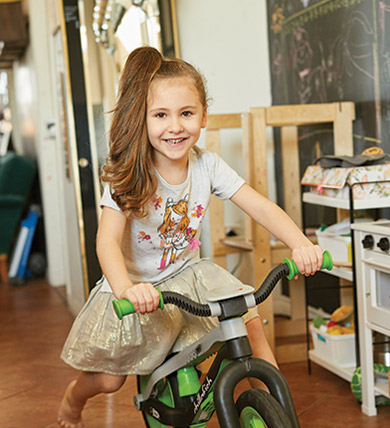Crawling, walking, running, jumping: children love to move. Moving keeps our bodies healthy and just feels good. That’s why it’s important to get your child in the habit of being active while having fun from a young age. How do you do it? Follow our guide!
By Julie Leduc
Physical activity supports child development. And it’s easy to get a toddler moving—just ask Karim Kammourieh, whose son Louaï will be turning 2 soon. “He’s a naturally active kid,” he says. “Nothing makes him happier than running, playing with a ball, or going to the park!”
Move as often as possible
From the first few months of life, babies should be moving several times a day. For example, when your baby plays on the floor or has tummy time, they’re being physically active. “When children move, they develop their senses, learn about their body, and explore their environment,” explains Félix Berrigan, a human kinetics professor at the Université de Sherbrooke. “Gradually, they also develop motor skills such as crawling, pulling, pushing, and walking.”
Starting at the age of 1, it’s recommended that young children get at least 3 hours of physical activity a day, according to the Canadian 24-hour Movement Guidelines. Starting at age 3, this active time should include at least 60 minutes of vigorous play per day—activities that get your child warmed up and raise their heart rate (e.g., dancing, running, tumbling, jumping).
“It can sound like a lot,” admits occupational therapist Noémie Lafortune. But it doesn’t have to be done all at once. “Every little bit counts. When your child’s goofing around running from the living room to the front door, that’s physical activity,” she says. And don’t forget about what they do at daycare!
Lastly, avoid letting your child stay seated for more than an hour at a time, for example in a car seat or stroller.
Benefits from early childhood
Physical activity helps your little one improve their endurance, balance, and coordination. “It also helps with posture and developing and strengthening muscles and bones,” says Peggy Gendron, a kinesiologist and creator of active games to get kids moving. Physical activity is also essential for proper brain development, starting at an early age. It contributes not only to your child’s physical development, but also to their social, emotional, and intellectual development.
Moving also allows your child to burn off energy and release tension, which can help relieve stress and anxiety. “Physical activity stimulates the secretion of hormones that help children calm down and be more receptive to learning,” adds Gendron. Marilène Provencher observed this in her almost 3-year-old son. “When he’s had an active day, Colin can stay focused during story time for longer, and his whole routine goes smoothly.”
In addition, the more active your child is, the more confident they’ll become in their physical abilities.
How do you encourage your child to move more?
Play is the best way to get your child moving. “You can race to the bathroom to brush your teeth, or crawl or jump on the way there,” says Gendron. You could also have a dance party with your child before dinner or stay out for an extra 15 minutes on the way home from daycare. Not only will you get your child moving, you’ll enjoy some quality parent-child bonding time.
Playing outside is obviously a great way to be active. “Children move more vigorously when they’re outside,” says Professor Félix Berrigan. “Why is that? It’s simple: there’s more space, more opportunity to move, and fewer constraints, and it seems to take less effort.” When kids play outside, they also face more physical challenges, such as climbing little hills or walking on uneven ground.

For their part, Emmanuelle Dion and Mathieu Leduc, parents of 4-and-a-half-year-old Alexandria, favour active transportation. “In the morning, Mathieu walks Alexandria to daycare,” says Emmanuelle. In addition, her daughter always has access to toys and equipment that help her get moving. “We leave her balance bike in the house and she uses it all the time. She also likes to use my exercise ball.” Children are also more likely to be active if they see that their parents lead an active lifestyle. For Dr. Berrigan, it’s important to focus on what your child enjoys and to avoid forcing them to play: “Remember, just have fun!”
Put the screens away
There are only 24 hours in a day, so when your child spends a good chunk of it in front of a screen, that means less time for physical activity. Remember, children shouldn’t be exposed to screens before the age of 2. From age 2 to 5, keep screen time limited to an hour a day. Once screen time is over, suggest some fun physical activities for your child to do.